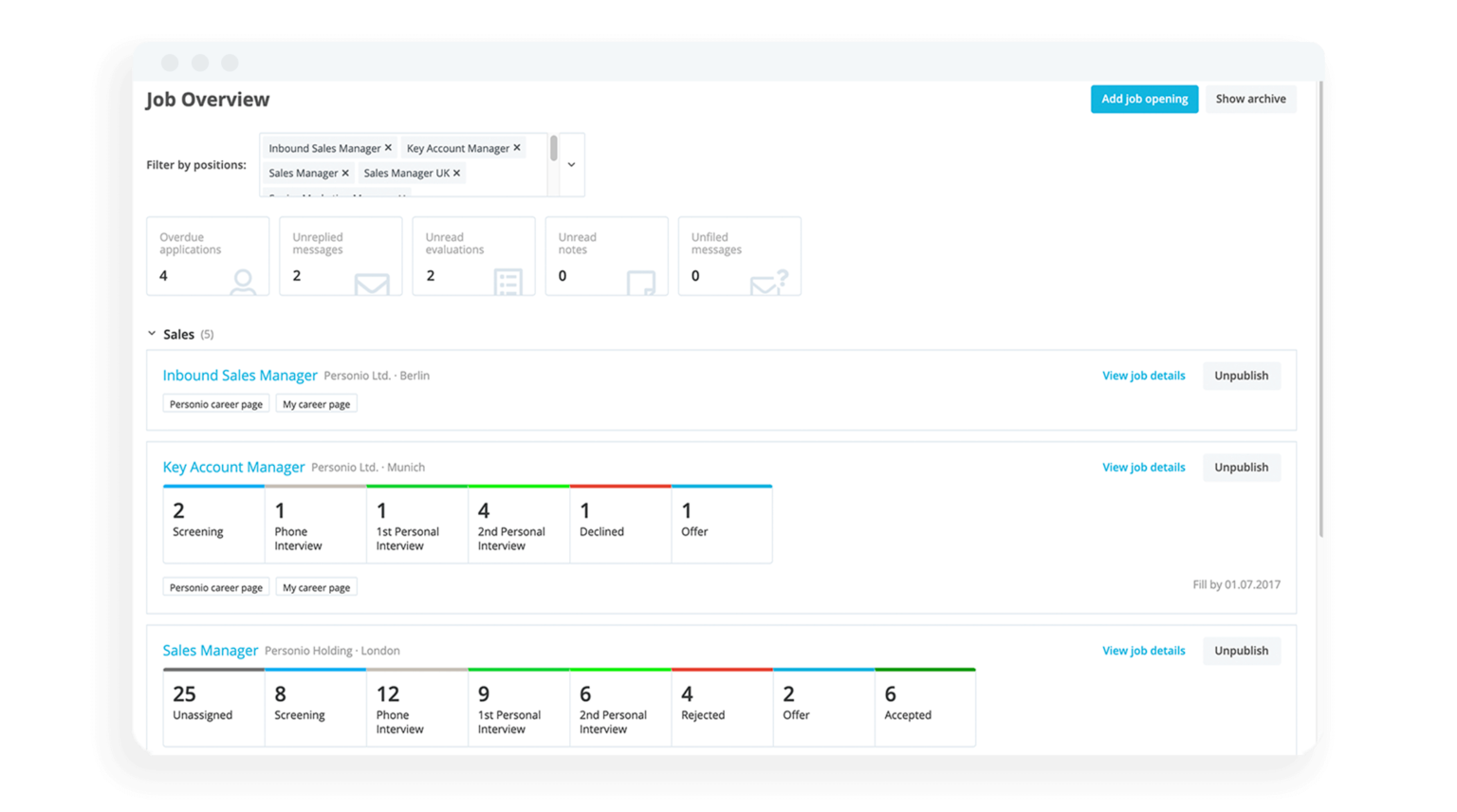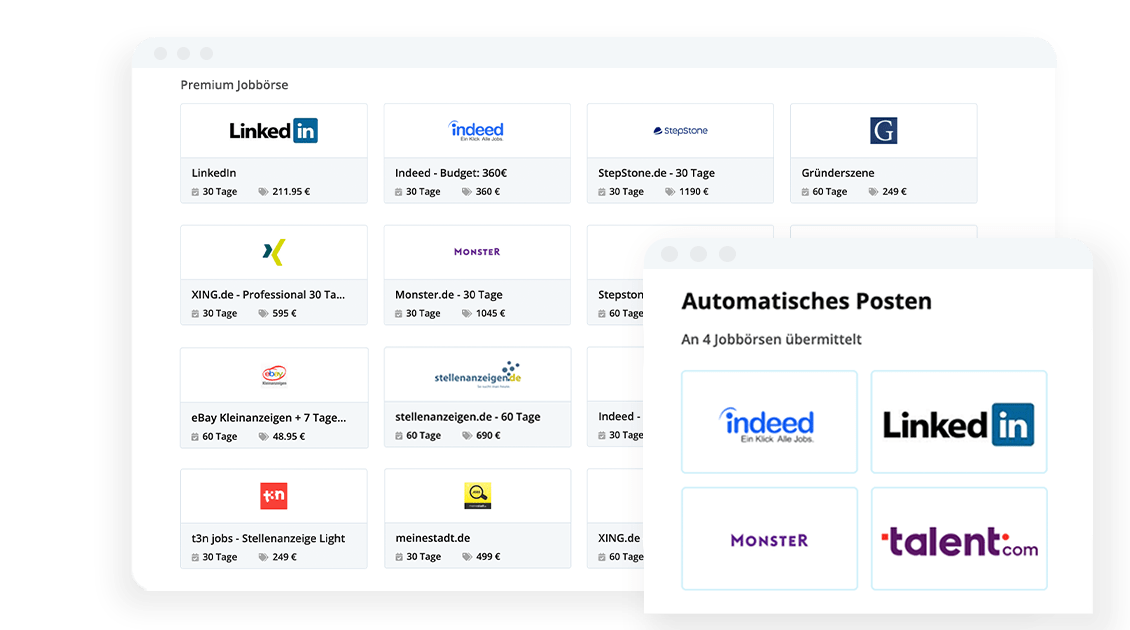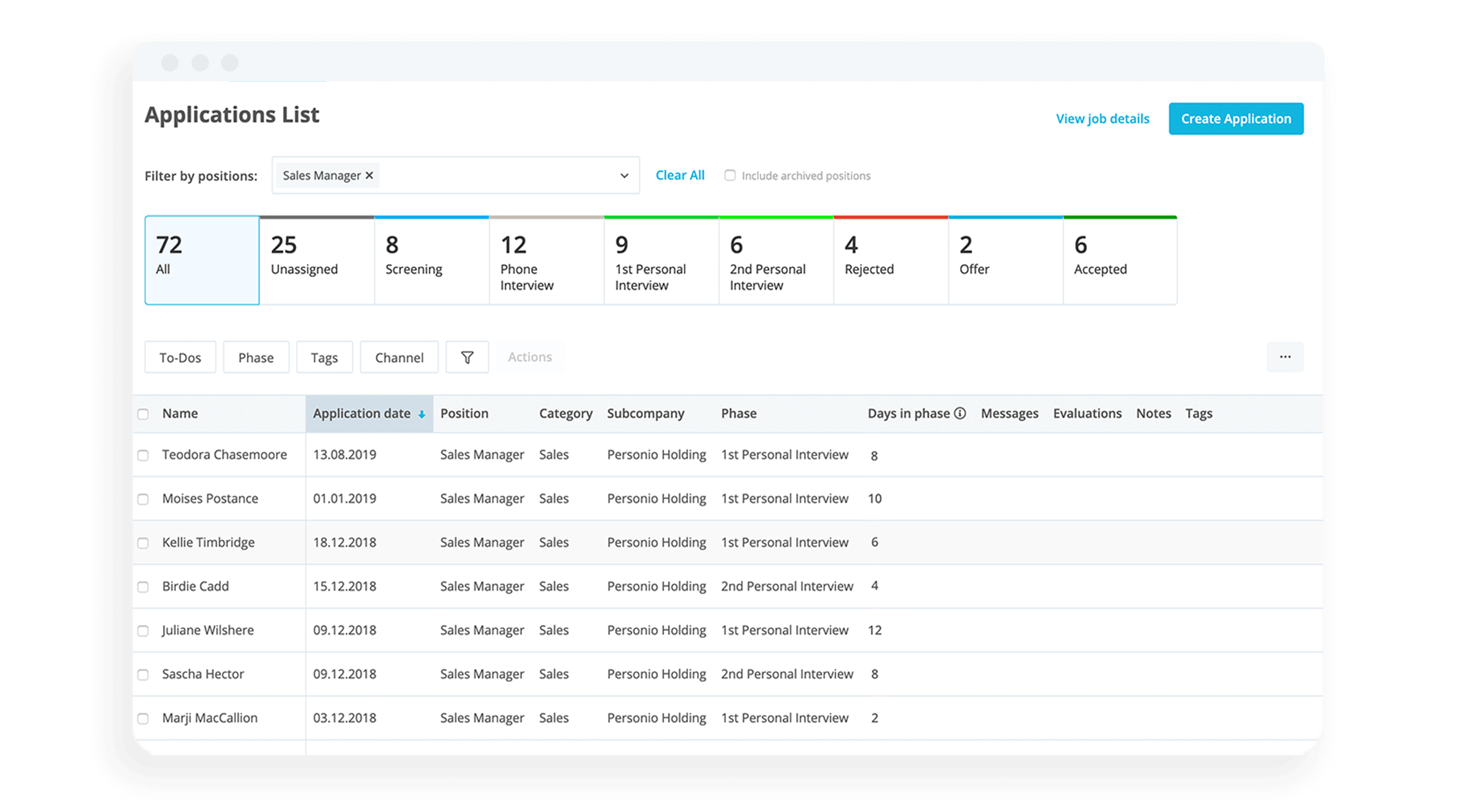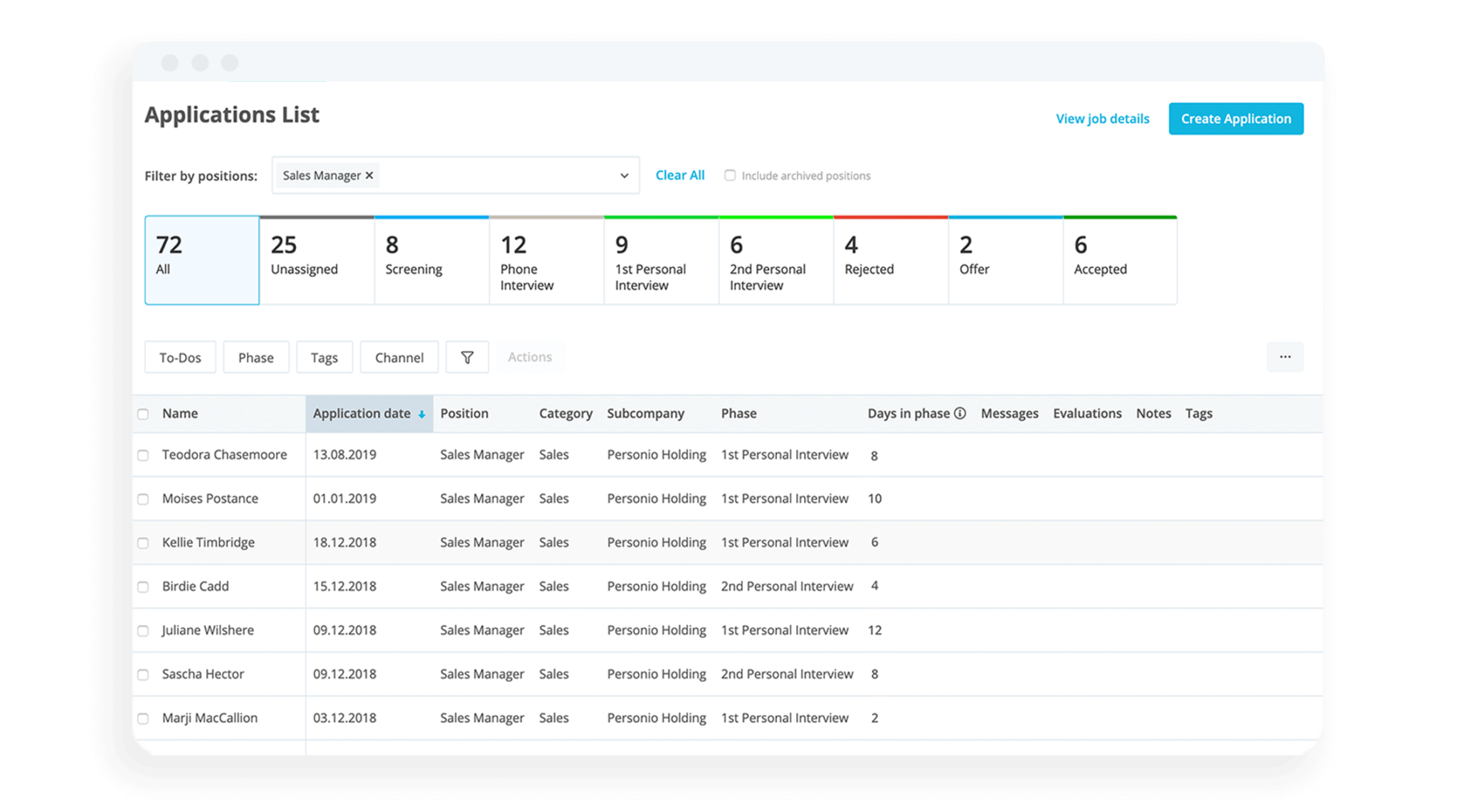External recruitment: Best practices for your business
When you have a job vacancy, you have two options: promote or transfer someone internally, or look for candidates outside of your organisation. In this article, we’ll discuss the pros and cons of external recruitment, and share some best practices to help you optimise your processes.
Take the stress out of recruiting top talent with Personio today.What is external recruitment?
External recruitment is when a business fills a vacant role with a candidate from outside the organisation. External recruitment is the go-to solution for most organisations, simply because there are only so many internal candidates available. The alternative is internal recruitment, which involves promoting or transferring an existing employee into a new role.
There are many different ways that an organisation can find external candidates, including:
Posting on online job boards
Recruiting through social media
Advertising on a company job portal
Using a recruitment agency
Attending job fairs and career events
Implementing an employee referral scheme
Not all channels work well for every role. For example, attending a job fair might be a good way to source candidates for high-volume, junior roles. But it’s unlikely to result in a hire for a senior executive position. For this reason, most companies use more than one sourcing method depending on the role they’re trying to fill.
Advantages of external recruitment
Here are some of the advantages of external recruitment:
Access to a wider pool of candidates: The number of candidates you can access through external recruitment is theoretically limitless. Logically, this means it gives you a better chance of finding the best person for the job than looking exclusively within your organisation.
Brings in an outside perspective: When you source candidates from the outside, they bring their unique experiences, ideas and perspectives with them — which can benefit your organisation.
Opportunity to reward employees: Employee referral programmes are a common way to source external candidates. As well as introducing you to talented professionals, they also allow you to reward your existing employees when a candidate they referred is successful.
Reduces internal competition and tension: When multiple employees are interested in a role, it can cause tension and disputes when one of them is selected. Hiring externally rather than internally can reduce conflict between employees.
Helps build a diverse organisation: Recruiting externally can help businesses reach candidates from a wide range of backgrounds. And not only is this the right thing to do, but there’s also a business case for it: A McKinsey report from 2020 found that organisations with diverse workforces are more profitable than other companies.
Disadvantages of external recruitment
Of course, external recruitment also comes with some downsides. For example:
Increased risk: External candidates are more of an unknown quantity than internal ones. That means there’s more of a risk of making the wrong decision and ending up with a bad hire.
Longer time-to-hire (T2H): Recruiting externally is a much longer process than recruiting internally, simply because narrowing down the field from a large pool of candidates takes a long time. This can result in positions being left open for longer than you’d like.
Increased cost and resources: External recruitment also comes with higher costs, both in terms of the time required for every stage of the process, and additional expenses like paid job boards and recruitment agency fees.
Need for more training: External hires typically take longer to understand the ins and outs of their new role, because they also have to familiarise themselves with the organisation. This might mean you have to spend more on training them than you would an internal hire.
Impact on employee morale: Employees might suffer from a decrease in morale and motivation if they thought they were a good fit for a role that was ultimately filled by an external candidate. In some cases, this can result in resentment towards the new hire, making it difficult for them to build rapport with their colleagues.
Create a great candidate experience

Organise applications, plan interviews and quickly evaluate candidates. Manage your entire hiring process with one tool with Personio.
Unlock Smoother HiringBest practices for external recruitment: our top tips
Want to optimise your external recruitment process and maximise your chances of landing a top candidate? Here are a few best practices to keep in mind.
Identify your best (and worst) sourcing channels

To give yourself the best chance of finding the right person for a role, your first step should be identifying your most promising sourcing channels.
The easiest way to start is by looking at what has worked for you in the past. You might find that some channels are effective for certain types of roles, but not others. That gives you a better idea of where to look for candidates for a particular opening.
Optimise your job descriptions to attract the right candidates
If you want to attract the right candidates to a role, you need to make sure you’re not putting them off with their job descriptions. But miscommunications in the early stages of the recruitment process often result in job descriptions that aren’t reflective of the actual role you’re hiring for.
For example, if a job description includes a requirement for a qualification that’s not actually necessary for the role, this could discourage qualified candidates from applying. Equally, if your job description doesn’t include something that is necessary, you might end up wasting time on unsuitable candidates.
You should also be careful about the language you use in your job description to make sure you’re attracting a diverse range of candidates. For example, there’s evidence that overly ‘masculine’ language could put off women from applying even if they’re qualified.
Keep candidates in the loop

Effective communication with candidates is key to a positive candidate experience. That means you should always keep them informed about the status of their application — even if they’re not selected to move forward.
The reason is that candidates who are kept in the dark might end up with a negative impression of your company — and your employer brand could suffer as a result. According to a recent survey, candidates who have negative hiring experiences are 185% less likely to be willing to refer other job seekers to your company.
Plus, there’s even evidence that a bad candidate experience could impact your bottom line: more than half of the respondents to another survey said they would be less likely to purchase from a brand after a negative hiring experience.
Showcase your company culture throughout the process
The recruitment process isn’t just about the role you’re trying to fill. You should also show candidates what it’s like to work at your organisation — in other words, your company culture.
This begins with your job descriptions, which should highlight the things that make your current employees happy, like your flexible work policy or any unusual perks you offer. Even the language you use in your job descriptions can express your company culture — for example, informal language usually suggests a less formal work environment.
You should also consider other ways to showcase your company culture throughout the recruitment process. For example, you could consider giving site or office tours to shortlisted candidates. Involving employees in the interview process is also a great way to give candidates a taste of what your organisation is like.
Use an applicant tracking system (ATS)

One of the biggest advantages of external recruitment is that it gives you access to an immense pool of potential candidates. But assessing and shortlisting those applications manually is almost impossible. That’s why our biggest piece of advice for optimising your external recruitment process is to use an applicant tracking system, or ATS.
This is a piece of software that can help you streamline and automate recruitment tasks. For example, an ATS can parse CVs to eliminate unsuitable candidates and avoid wasting time.
ATS software can also help you keep track of all of your applicants in one place, so you can see the status of each one at a glance. And some software can even send automatic communications to let candidates know when they’ve reached the next stage of the process.
Basically, an ATS is an invaluable addition to your hiring team. With the ATS taking care of your most time-consuming tasks, you’ll be able to focus on providing a stellar candidate experience and finding the best person for the job.
Keep track of your recruitment process with Personio
Personio is an all-in-one hiring and HR system that can help you manage the entire recruitment process from start to finish.
You can use Personio to create, publish and manage job postings with just a few clicks. And our seamless CRM software helps you track which sourcing channels are working for you (and which ones you need to cut). Our ATS allows you to automate and streamline the key parts of the recruitment process, and keep track of the entire hiring process in one place.
And, once you find the right person for the role, you can easily convert them from candidate to employee by sending a legally binding offer, right within Personio.
Want to learn more about what Personio can do? Book your free demo to see it in action.

